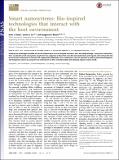| dc.contributor.author | Kwon, Ester | |
| dc.contributor.author | Lo, Justin H. | |
| dc.contributor.author | Bhatia, Sangeeta N | |
| dc.date.accessioned | 2016-08-25T15:38:19Z | |
| dc.date.available | 2016-08-25T15:38:19Z | |
| dc.date.issued | 2015-11 | |
| dc.date.submitted | 2015-06 | |
| dc.identifier.issn | 0027-8424 | |
| dc.identifier.issn | 1091-6490 | |
| dc.identifier.uri | http://hdl.handle.net/1721.1/103977 | |
| dc.description.abstract | Nanoparticle technologies intended for human administration must be designed to interact with, and ideally leverage, a living host environment. Here, we describe smart nanosystems classified in two categories: (i) those that sense the host environment and respond and (ii) those that first prime the host environment to interact with engineered nanoparticles. Smart nanosystems have the potential to produce personalized diagnostic and therapeutic schema by using the local environment to drive material behavior and ultimately improve human health. | en_US |
| dc.description.sponsorship | National Cancer Institute (U.S.) (Koch Institute Support Grant P30-CA14051) | en_US |
| dc.description.sponsorship | National Institute of Environmental Health Sciences (Core Center Grant P30-ES002109) | en_US |
| dc.description.sponsorship | Amar G. Bose (research grant) | en_US |
| dc.description.sponsorship | United States. Defense Advanced Research Projects Agency (Cooperative Agreement HR0011-13-2-0017) | en_US |
| dc.language.iso | en_US | |
| dc.publisher | National Academy of Sciences (U.S.) | en_US |
| dc.relation.isversionof | http://dx.doi.org/10.1073/pnas.1508522112 | en_US |
| dc.rights | Article is made available in accordance with the publisher's policy and may be subject to US copyright law. Please refer to the publisher's site for terms of use. | en_US |
| dc.source | National Academy of Sciences (U.S.) | en_US |
| dc.title | Smart nanosystems: Bio-inspired technologies that interact with the host environment | en_US |
| dc.type | Article | en_US |
| dc.identifier.citation | Kwon, Ester J., Justin H. Lo, and Sangeeta N. Bhatia. “Smart Nanosystems: Bio-Inspired Technologies That Interact with the Host Environment.” Proc Natl Acad Sci USA 112, no. 47 (November 23, 2015): 14460–14466. © 2016 National Academy of Sciences. | en_US |
| dc.contributor.department | Massachusetts Institute of Technology. Institute for Medical Engineering & Science | en_US |
| dc.contributor.department | Koch Institute for Integrative Cancer Research at MIT | en_US |
| dc.contributor.mitauthor | Kwon, Ester | en_US |
| dc.contributor.mitauthor | Lo, Justin H. | en_US |
| dc.contributor.mitauthor | Bhatia, Sangeeta N. | en_US |
| dc.relation.journal | Proceedings of the National Academy of Sciences | en_US |
| dc.eprint.version | Final published version | en_US |
| dc.identifier.pmid | 26598694 | |
| dc.type.uri | http://purl.org/eprint/type/JournalArticle | en_US |
| eprint.status | http://purl.org/eprint/status/PeerReviewed | en_US |
| dspace.embargo.terms | N | en_US |
| dc.identifier.orcid | https://orcid.org/0000-0001-5981-2589 | |
| dc.identifier.orcid | https://orcid.org/0000-0002-1293-2097 | |
| dc.identifier.orcid | https://orcid.org/0000-0002-6335-9681 | |
| mit.license | PUBLISHER_POLICY | en_US |
